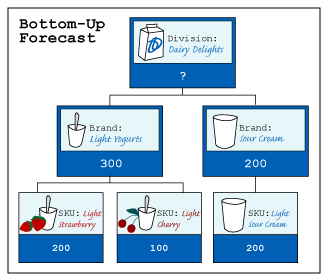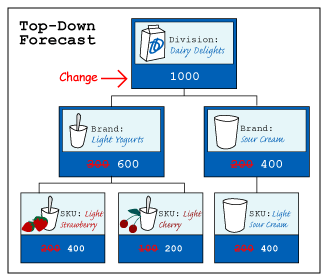Disaggregate Forecast
In demand planning terminology, Forecast Reconciliation is also referred to as Bottom-up and Top-down Forecasting or Proportional Forecasting. Forecast Reconciliation, however, could also stand for reconciling the demand forecast with a modeled forecast vs. a judgmental forecast or a financial forecast.
In this article, we will be reconciling a top-down forecast and Bottom-up forecast through aggregation and disaggregation methodology. The second title is more direct in referring to this process as “Bottom-up/Top-Down forecasting”, but we may also call it “Proportional forecasting” since this method involves using proportions to develop the disaggregated detail level forecasts into the future.
Bottom-up/Top-Down forecasting 
Adding more excitement to this menu of terminology, different software tools have different methodologies to perform forecast reconciliation between the different levels of forecast. Typically, forecast reconciliation is sought after in cases where you need to forecast multiple levels of the product hierarchy, so in some sense it’s aligned with product grouping and product hierarchy. If you are also forecasting at the customer level, then the levels of aggregation multiply by the customer dimension. Customers may roll up into a sales territory, sales district, and sales region to the national level. In this article, we are going to limit ourselves to illustrating forecast aggregation and disaggregation just using the product hierarchy. We would abstract away from further disaggregation at the customer SKU level.
When you develop your forecasting process, you have a choice to make – at what level do you develop the forecast? You could forecast at SKU level or slightly higher (at brand or sub-brand level) or, given a simpler supply chain you could get away with forecasting at the category or division level.
When forecasting for the supply chain, as a general rule, you forecast at the SKU level. When you have a process focused on this type of detailed forecasting, you could aggregate an SKU level forecast to a higher level forecast, dollarize it, and use it for financial planning, which is the typical methodology for Bottom-up forecasting.

In Top-Down forecasting, the forecasts are developed at the brand, category or division level, and then allocated down to the lower levels (to SKU, then to SKU/Warehouse).
There are different schools of thought, arguing that either method is superior. One approach says that forecasting at the detail level results in a much more accurate forecast because information at the detail level is more precise. Aggregating this detailed forecast with a time series of prices produces a realistic view of the financial plan.
The alternate view, which is equally plausible and fair, states that forecasting at the SKU level produces too much noise. At the SKU level, volumes could be very light; some of
the SKUs could be shipped very infrequently. So the lower the level, the more difficult it becomes to create any useful statistical model because of sketchy and intermittent demand data. If that is the case, forecasting at the SKU/customer level will magnify the impact of noise and data infrequency. Forecasting at the customer SKU level also means aggregating not only at the customer SKU to the SKU level, but also aggregating all the way to the top, to the division level.